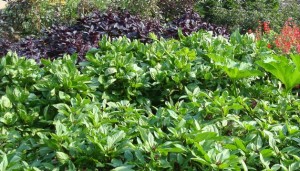To grow this tender annual from seed, sow in flats about 6 weeks before last frost. Sow seeds and cover with the growing medium to about twice the depth of the seed. Keep soil at 70-72 degrees F, and keep moist. Basil seedlings are very sensitive and most losses occur due to low moisture and low temperatures. If not crowded in the seed flat, do not thin, but let them grow to 3 to 4 inches before transplanting. Basil likes the warmth of full sun to grow best. Lift transplants carefully by the leaves instead of the stem. Set outdoors only after soil and air temperatures are warm. One chilly night can set plants back.
Basil can be directly sown in the garden after soil has warmed up and nights are not too cool. Be sure to sow to a depth of twice the size of the seed or heavy rains may wash the seeds away. Purple basil, lacking chlorophyll, is more susceptible to shock in the early stages.
Sweet green basil can be dried, frozen in ice cubes, or used fresh. Blended with pine nuts, oil and cheese, this basil is the prime ingredient in pesto. It is also good for making flavored vinegar for salad dressing, or suffused in oil for flavored oil. Purple basil is best used fresh in salads, and for making flavored vinegar. In the garden, purple basil is a colorful contrast to annual flowers, and its color is useful in cut arrangements.
Chives
There are several forms of chives, but the most common one has roundish leaves that are used for their onion-like flavor. This perennial is hardy to Zone 3. In spring, it has lovely purple flowers made up of masses of florets.
From seed, sow indoors and cover lightly with the medium about 6 to 8 weeks before the last frost. Plant in potting soil in a deep container or flat. Sprouting will occur in about 10 to 14 days at 60 to 70 degrees F. Set seedlings in clumps in the garden. Outdoors, seed can be sown in furrows or broadcast to grow in clumps. Chives like full sun and rich soil. They can take partial shade, but will not grow as fully erect. The leaves will die back in the summer heat, but may return in the fall. Clumps should last four to five years before dividing.
Chives can be harvested for fresh use in salads and recipes. Cut a few leaves to the base, but don’t shear the whole plant down to the base or they won’t be able to manufacture food for the roots. The flower heads can be used to make chive vinegar, and the flowers can also be dried. To dry the flowers, put them in a paper bag, but leave the mouth of the bag open. Don’t tie the stems together or they may rot instead of dry.
Chives can be dried by snipping the leaves as you would for a salad, and then placing them on a fine screen or nylon mesh in a warm place, out of direct light. Stir regularly for several days. When dry, seal in jars.
Lemon Verbena
Lemon verbena is a tender perennial that is best purchased as a growing plant. In the garden it needs full sun and temperatures above 65 degrees F for best growth.
Lemon verbena leaves can add a fresh flavor to fruit salads or beverages, but they are best removed before serving because the leaves are very difficult to chew. The leaves can be dried by placing them on a screen or mesh in a warm place out of bright light. The dried leaves can be used to make a tea.

Leave a Reply
You must be logged in to post a comment.